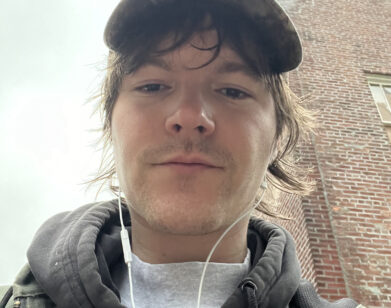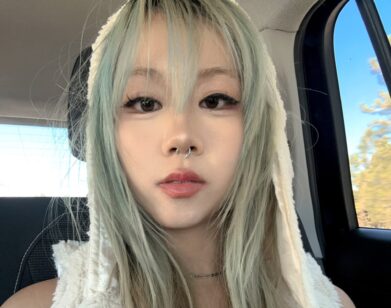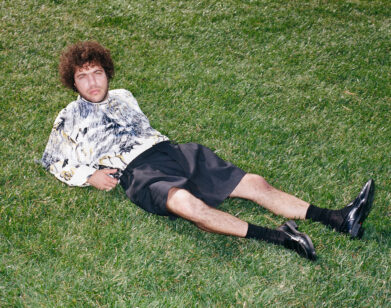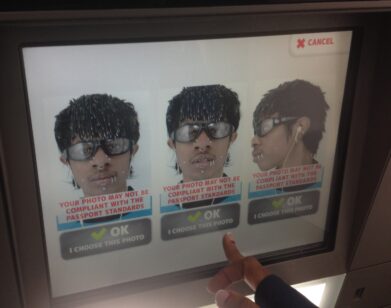Jamila Woods: Maker, Mentor, Musician
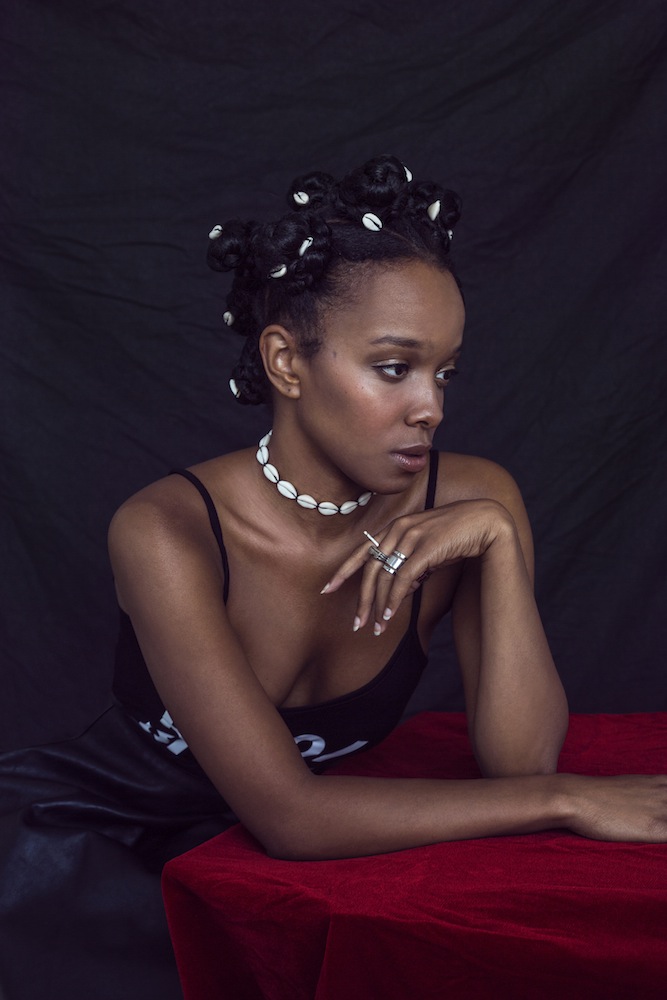
JAMILA WOODS IN NEW YORK, SEPTEMBER 2016. PHOTO: VICTORIA STEVENS. MAKEUP: KATHERINE REEL FOR KATHERINEREEL.COM.
How to capture the many roles of Jamila Woods? She’s a teacher, a mentor, a poet and singer, a student of history, a collagist, a space-maker. Born in Chicago, where she currently resides, Woods—when she’s not working with globally known musicians such as Chance the Rapper and Macklemore, or on her own acclaimed music—serves as an artistic director at Young Chicago Authors (YCA). Her poetic upbringing through groups like YCA has not only contributed to the lyrical deftness of her music; it has also inspired her to transform spaces of performance into spaces of connectivity.
Consider the unorthodox launch party for her debut album HEAVN (Closed Sessions): To celebrate its recent release on June 23, Woods hosted what she dubbed a “party/concert/indoorfestival/comethruuuuu” at Double Door, one of Chicago’s most iconic venues. The tone was set with DJs, dance, stand-up comedy, Simon Says, face painting, poetry readings, an abundance of food and drink, board games, and a photo booth with vibrantly painted sets. It was a night for love, a celebration of black girl magic, and a variegated coming together—all of which remain integral to Woods’s approach, whether on stage, in conversation, or straight from a song to her listener.
Today, Woods announced a string of U.S. dates taking place through November and December. On November 19, she will play her final hometown show of 2016 at the Museum of Contemporary Art Chicago.
THE HEAVN RELEASE PARTY: I wanted it to be a space where people felt comfortable, building a community even if they came by themselves—what I hear house parties originally were, like someone’s living room. The vendors I had were all women, mostly women of color, who I handpicked from seeing them around, some of them my friends who make their own art or clothing. It felt good to have them have a space. And games, because I’m the kind of person who likes options. I’m an introvert, so I think it’s great to have Connect Four in the corner, or mancala, one of my favorite games when I was younger. It’s a way for people to break the ice. My friend Jasmine [Barber] did a Simon Says sort of activity to get everyone chill. I also wanted some of my students and mentees to open the show. And Sonia [Denis], the comedian, I had just seen her at Second City and thought she was dope. I love curating stuff. I think that’s an art form in itself. The space around the music was important.
That night is still my favorite performance. It was my first headlining performance actually. I had done a couple of shows trying out the music, but it was my first show having finished the album. I loved the moment when my friend Danez Smith did a poem and Dominique Johnson, a member of the Happiness Club, [a Chicago-based youth performance group], danced along with it. I can really only do stuff like that when I’m in my home base, where I know everybody involved. I want to move toward doing a lot more stuff like that. I am a poet, and I get a lot of inspiration for my songs from other poets and their poems, so having Danez perform that poem “summer, somewhere,” at home, that’s a poem that continuously inspires my writing and a lot of HEAVN.
CHICAGO SPACES AND MUSIC AS COMMUNITY MAKING: When you think about a concert space, if you don’t vibe with the artist’s fans, at least I don’t want to go to that artist’s concerts anymore. And that’s sad. Music is something that is supposed to connect people on a pure level. Coming up through Louder Than a Bomb [the world’s largest poetry festival], it was constantly said to us: We are creating a counter-culture against the culture that says someone like me, who lives on the south side of Chicago, in Beverly, should never really meet with my friend on the west side, that we’re not supposed to know each other. People are taught not to interact. Coming up in that space it was never just about writing poems, or even getting to perform my poem: it was an opportunity to hear from another person, to empathize and understand their story and see a whole school or side of the city differently. That’s where it started in my mind: art always being linked to community. Even thinking through the album, how I was inspired by black girls, writing from a very specific space, inspired by what I thought I wanted to hear when I was younger, or what I would tell my sisters, or what I would tell some of my students, young black women. Sometimes though… I got an e-mail from someone in Ohio who wrote, “I’m a white man, I don’t know why, but I like your album, and I relate to it.” And I responded “Of course!” Just because that’s where my inspiration comes from doesn’t limit the effect it can have, so I always want any space created around my music to feel inclusive in that way, so that it is specific, but also inclusive. And that may empower people to step out of their comfort zone or accept someone standing next to them they usually wouldn’t.
ART VS. POLITICS: My art gets called political, as opposed to my intending it to be political. I think that’s something that happens with black artists or marginalized voices trying to speak truth. Because there are things in the status quo to speak out against, speaking out against them will inherently be political. When I went to Brown [University] I got a lot of language to talk about and understand oppressions. That was useful. I think back on my life and see I wasn’t alone in an experience: I didn’t like my natural hair for so long and that’s not my fault. It’s not because I have terribly low self-esteem as a person, it’s because I was shown images, what’s beautiful and what’s not, for example. Coming back to Chicago after school, though, that is not always the language of politics; knowing isms, or certain dichotomies, it’s not always useful in the spaces I’m frequently in. Having music as a way to communicate those things is about naming experiences. Naming something, putting it on record, in a lyric, feels like affirming people. Ideally that’s what politicians should want to do: to put laws or policies in place that speak to people’s experiences, to make them feel heard.
MUSIC AS PROTEST: It was Audre Lord who said something like, “My self-care is an act of radical resistance.” People think of protests as a negative thing or a militant thing. Definitely, “activist” or “protest” mean so many things, but there’s a lack of that holistic view, of the humanness that it takes to actually protest, or what it takes to actually get up and go to work the day after a black person was killed. You need something to keep you going through that, something that allows you to sit and cry if that’s what you need to do. That comes from a Thomas Dorsey song we used to sing in my choir, [the Chicago Children’s Choir]. I found that in church too. There’s a utility to music, it’s very practical, that transitions us from the church announcements to the sermon, the music in-between, from collecting offerings, a song that makes everyone feel good enough to give that offering—there’s a purpose. And it’s also there to allow people to emote, to feel cleansed. From a very young age I observed that.
SPEAKING OUT AFTER BLACK DEATHS: When people were interviewing artists after something happened… I have to go off of authentically how I feel. I did participate in one conversation around Rekia Boyd, because that’s an issue I feel more knowledgeable about, more close to, it hits close to home for me. I’ve seen her family members at different events and heard them speak and understand a lot about that. With Philando Castile, I might not feel like I’m the one who should be speaking out, maybe I’m not in an emotional space to even speak about that. I don’t think that choice should be made for the wrong reason. That’s important for artists to remember: some people would like to be spokespeople, but others would like their art to speak.
BEING A MENTOR: It’s a whole different space. As an educator, or someone in a mentor position, I feel a responsibility to provide a space for that conversation [about police killings], even if I don’t feel ready, if I don’t have the answers, which I usually don’t know. It’s important I provide a space for those emotions; there’s fear, there’s sadness. It’s good to just allow space and affirm that it is okay, that there’s no right way to feel after this. And we do provide for a lot of poems and a lot of songs in that space, not as an answer, but as a way to understand something. That Danez poem, [“summer, somewhere,”] I mentioned is a way to understand something: that poem imagines an alternative heaven for black people. The Flying Lotus video “Until the Quiet Comes” is a way to understand something. So we [Young Chicago Authors] will do a lot of workshops like that; as opposed to feeling like I have to provide guidance, really, it’s that we’re going to guide ourselves collectively. That’s the way we teach in general. It’s a democratic student centered space. We learn from each other.
HER FEATURE ON MACKLEMORE & RYAN LEWIS’S “WHITE PRIVILEGE II”: There was a specific audience for that. Ben and Ryan were thinking about their own audience and wanting to challenge them, to push them out of similarity. Their audience is mostly white people. And also the long trajectory of the song, I felt my part in it was to do that thing that music does. Some people described my part like, “Whew, that was a rest at the end,” a breath at the end of the song, after all this dense information, which for some people was tough stuff to hear. But I was also trying to represent a multiplicity of voices even in my one part, because that’s the most authentic way I can enter into that conversation. I’m not going to be the spokesperson for Black Lives Matter, but I will allude to this MLK quote and this Audre Lord quote and just talk about hip-hop. I was trying to speak to an audience I don’t usually speak to. But I also think specificity is a good exercise, to write to different audiences. That was a new one for me.
THE PRESSURE TO SPEAK TO WHITE AUDIENCES ABOUT WHITE PRIVILEGE: I did feel that when “White Privilege II” came out, but because I work mostly with students of color on a day-to-day basis I don’t feel it much. There’s so much that exists for that conversation, that if I do get approached with it, I’m just like, “Here’s all of this information.” It’s not a “talk to the hand” sort of thing, just literally there’s a lot. We did a really cool event here with Macklemore and some poets, my students, who wrote poems in response to the song. We had a panel, and this group called SURJ [Showing Up for Racial Justice] took up leading these “authentic allyship” workshops at YCA. We had some black activists on a panel and one of them straight up said, “I don’t want to be here right now. I hate telling you guys what you should know.” They were very honest about that. SURJ had a lot of meetings then too; they were at capacity. I think that model can really work. That’s what good allyship or accomplice-hood looks like to me, having those conversations again and again, to take that burden off of people of color to always be conducting them. Yes, white privilege exists, but that means you have access to things to help the movement, to help fight for equality and for liberation of black people. For me, when we [Young Chicago Authors] have our festival in the spring, it’s powerful to see what young people in Chicago are thinking about, as opposed to [the stereotype] that they live just in a really violent place. To actually hear it from the source, however, to do intentional listening in that way, is really good.
STARTING NOVEMBER 4, 2016, JAMILA WOODS IS TOURING THE U.S. FOR MORE ON JAMILA WOODS, VISIT HER WEBSITE.

